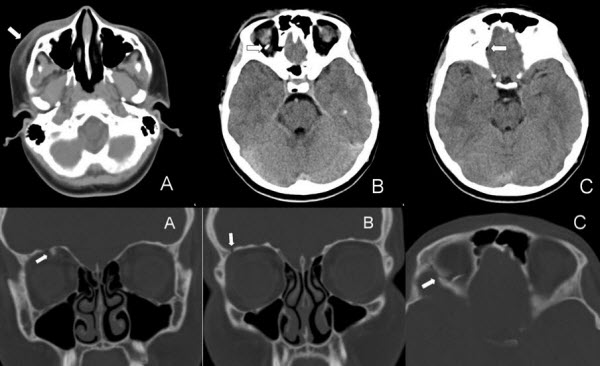Orbital Roof Fracture Radiology

A orbital fractures can occur in isolation or with other fracture patterns.
Orbital roof fracture radiology. This is typically caused by a direct blow to the central orbit from a fist or ball. Assessing traumatic orbital injuries is an important challenge for radiologists. Orbital fracture pearls are as follows. Orbital roof fracture icd 801 01 etiology.
Angulated displaced fractures fragments are seen projecting downwards within the orbit indenting the superior rectus muscle. Fracture of the left zygomaticomaxillary attachmnet with fracture of the anterior and lateral maxillary walls inferior orbital rim fracture and left maxillary hemosinus. The orbital roof is composed of the orbital plate of the frontal bone with a small contribution from the lesser wing of the sphenoid at the apex figures 3 4 and 3 5. Common posttraumatic orbital injuries include anterior chamber injuries injuries to the lens open globe injuries ocular detachments intraorbital foreign bodies carotid cavernous fistula and optic nerve injuries.
This assessment is even more difficult when the orbital injury is associated with injuries involving multiple organs. Fractures of the orbital roof are usually seen in combination with extension of linear frontal bone fractures or with complex cranial facial fractures including le fort iii naso orbito ethmoidal noe skull base fractures extending into the anterior skull base. Radiological considerations in the setting of orbital roof fracture it is important to fully assess the extent of the fracture including any radiographically apparent concomitant abnormalities. Isolated orbital roof fractures in adults are uncommon comprising 12 19 of all orbital wall fractures.
Most roof fractures are associated with other orbital fractures and result from significant head trauma as a high degree of force is required to fracture this portion of the orbit. The injury can be associated with a violation of the dura necessitating an intracranial approach. Communited mildly depressed left orbital roof fracture. It is a thin lamina separating the orbit anteriorly from the frontal sinus and posteriorly from the anterior cranial fossa.
As an isolated orbital roof fracture is a rare entity it is important to. Ct scan revealed widening of the frontal bone fracture and the left orbital roof fracture with a hypodense cystic swelling in the left orbit and upper eyelid and left frontal lobe contusion. Radiological considerations in the setting of orbital roof fracture it is important to fully assess the extent of the fracture including any radiographically apparent concomitant abnormalities. Although common in the pediatric population isolated orbital roof fractures can also occasionally occur in an adult fig 13.
A three dimensional ct reconstruction demonstrated the extent and shape of the skull fracture fig. Very rarely the orbital roof will fracture without displacement of fractures fragments resulting in the non displaced orbital roof fracture.














































